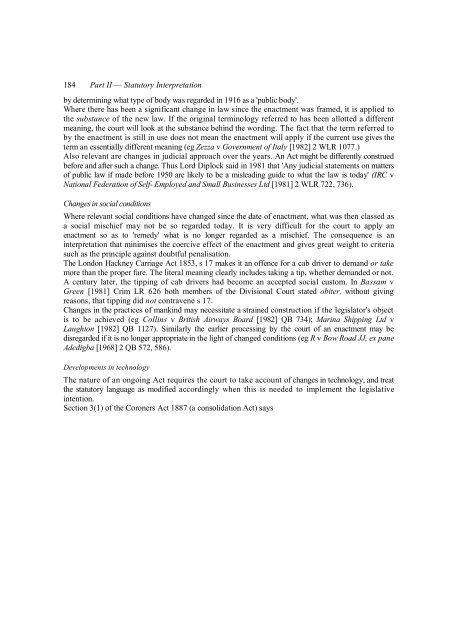Statutory Interpretation The Technique of Statutory ... - Francis Bennion
Statutory Interpretation The Technique of Statutory ... - Francis Bennion
Statutory Interpretation The Technique of Statutory ... - Francis Bennion
Create successful ePaper yourself
Turn your PDF publications into a flip-book with our unique Google optimized e-Paper software.
184 Part II — <strong>Statutory</strong> <strong>Interpretation</strong><br />
by determining what type <strong>of</strong> body was regarded in 1916 as a 'public body'.<br />
Where there has been a significant change in law since the enactment was framed, it is applied to<br />
the substance <strong>of</strong> the new law. If the original terminology referred to has been allotted a different<br />
meaning, the court will look at the substance behind the wording. <strong>The</strong> fact that the term referred to<br />
by the enactment is still in use does not mean the enactment will apply if the current use gives the<br />
term an essentially different meaning (eg Zezza v Government <strong>of</strong> Italy [1982] 2 WLR 1077.)<br />
Also relevant are changes in judicial approach over the years. An Act might be differently construed<br />
before and after such a change. Thus Lord Diplock said in 1981 that 'Any judicial statements on matters<br />
<strong>of</strong> public law if made before 1950 are likely to be a misleading guide to what the law is today' (IRC v<br />
National Federation <strong>of</strong> Self- Employed and Small Businesses Ltd [1981] 2 WLR 722, 736).<br />
Changes in social conditions<br />
Where relevant social conditions have changed since the date <strong>of</strong> enactment, what was then classed as<br />
a social mischief may not be so regarded today. It is very difficult for the court to apply an<br />
enactment so as to 'remedy' what is no longer regarded as a mischief. <strong>The</strong> consequence is an<br />
interpretation that minimises the coercive effect <strong>of</strong> the enactment and gives great weight to criteria<br />
such as the principle against doubtful penalisation.<br />
<strong>The</strong> London Hackney Carriage Act 1853, s 17 makes it an <strong>of</strong>fence for a cab driver to demand or take<br />
more than the proper fare. <strong>The</strong> literal meaning clearly includes taking a tip, whether demanded or not.<br />
A century later, the tipping <strong>of</strong> cab drivers had become an accepted social custom. In Bassam v<br />
Green [1981] Crim LR 626 both members <strong>of</strong> the Divisional Court stated obiter, without giving<br />
reasons, that tipping did not contravene s 17.<br />
Changes in the practices <strong>of</strong> mankind may necessitate a strained construction if the legislator's object<br />
is to be achieved (eg Collins v British Airways Board [1982] QB 734); Marina Shipping Ltd v<br />
Laughton [1982] QB 1127). Similarly the earlier processing by the court <strong>of</strong> an enactment may be<br />
disregarded if it is no longer appropriate in the light <strong>of</strong> changed conditions (eg R v Bow Road JJ, ex pane<br />
Adedigba [1968] 2 QB 572, 586).<br />
Developments in technology<br />
<strong>The</strong> nature <strong>of</strong> an ongoing Act requires the court to take account <strong>of</strong> changes in technology, and treat<br />
the statutory language as modified accordingly when this is needed to implement the legislative<br />
intention.<br />
Section 3(1) <strong>of</strong> the Coroners Act 1887 (a consolidation Act) says

















